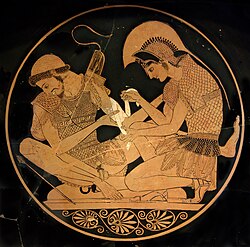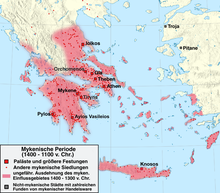Historicity of the Homeric epics
This article needs attention from an expert in Classical Greece and Rome. (September 2015) |
| Trojan War |
|---|
 |
| The war |
|
Setting: Troy (modern Hisarlik, Turkey) |
| Literary sources |
| See also: Trojan War in popular culture |
| Episodes |
| Greeks and allies |
|
| Trojans and allies |
|
| Participant gods |
|
Caused the war: On the Greek side:
On the Trojan side: |
| Related topics |
|
The extent of the historical basis of the Homeric epics has been a topic of scholarly debate for centuries. While researchers of the 18th century had largely rejected the story of the Trojan War as fable, the discoveries made by Heinrich Schliemann at Hisarlik reopened the question in modern terms, and the subsequent excavation of Troy VIIa and the discovery of the toponym "Wilusa" in Hittite correspondence has made it plausible that the Trojan War cycle was at least remotely based on a historical conflict of the 12th century BC, even if the poems of Homer are removed from the event by more than four centuries of oral tradition.
History[]
In antiquity, educated Greeks accepted the truth of human events depicted in the Iliad and Odyssey, even as philosophical scepticism was undermining faith in divine intervention in human affairs. In the time of Strabo, topographical disquisitions discussed the identity of sites mentioned by Homer. This continued when Greco-Roman culture was Christianised: Eusebius of Caesarea offered universal history reduced to a timeline, in which Troy received the same historical weight as Abraham, with whom Eusebius' Chronologia began, ranking the Argives and Mycenaeans among the kingdoms ranged in vertical columns, offering biblical history on the left (verso), and secular history of the kingdoms on the right (recto).[1] Jerome's Chronicon followed Eusebius, and all the medieval chroniclers began with summaries of the universal history of Jerome.
With such authorities accepting it, post-Roman Europeans continued to accept Troy and the events of the Trojan War as historical. Geoffrey of Monmouth's pseudo-genealogy traced a Trojan origin for royal Briton descents in Historia Regum Britanniae.[2] Merovingian descent from a Trojan ancestor was embodied in a literary myth first established in Fredegar's chronicle (2.4, 3.2.9), to the effect that the Franks were of Trojan stock and adopted their name from King Francio, who had built a new Troy on the banks of the river Rhine (modern Treves).[3] However, even before the so-called Age of Enlightenment of the 18th century these supposed facts of the medieval concept of history were doubted by Blaise Pascal: "Homer wrote a romance, for nobody supposes that Troy and Agamemnon existed any more than the apples of the Hesperides. He had no intention to write history, but only to amuse us."[4] During the 19th century the stories of Troy were devalued as fables by George Grote.[5]
The discoveries made by Heinrich Schliemann at Hisarlik revived the question during modern times, and recent discoveries have resulted in more discussion.[6] According to Jeremy B. Rutter, archaeological finds thus far can neither prove nor disprove whether Hisarlik VIIa was sacked by Mycenaean Greeks sometime between 1325 and 1200 BC.[7]
No text or artefact found on the site itself clearly identifies the Bronze Age site by name. This is due probably to the levelling of the former hillfort during the construction of Hellenistic Ilium (Troy IX), destroying the parts that most likely contained the city archives. A single seal of a Luwian scribe has been found in one of the houses, proving the presence of written correspondence in the city, but not a single text. Research by Anatolian specialists indicates that what is called "Troy" was in the Late Bronze Age known to the Hittites as the kingdom of Wilusa, and that it appears that there were several armed conflicts in the area at the end of the Late Bronze Age,[6] although this does not identify the combatants.
The bilingual toponymy of Troy/Ilion is well established in the Homeric tradition. The Mycenaean Greeks of the 13th century BC had colonized the Greek mainland and Crete, and were beginning to make forays into Anatolia. Philologist Joachim Latacz identifies the "Achaioi" of the Illiad with the inhabitants of Ahhiyawa. He posits that in all probability the Iliad preserved through oral hexameters the memory of one or more acts of aggression perpetrated by the Ahhiyawans against Wilusa in the thirteenth century B.C.[8]
Status of the Iliad[]
The more that is known about Bronze Age history, the clearer it becomes that it is not a yes-or-no question but one of educated assessment of how much historical knowledge is present in Homer, and whether it represents a retrospective memory of Dark Age Greece, as Finley concludes, or of Mycenaean Greece, which is the dominant view of A Companion to Homer, A.J.B. Wace and F.H. Stebbings, eds. (New York/London: Macmillan 1962). The particular narrative of the Iliad is not an account of the war, but a tale of the psychology, the wrath, vengeance and death of individual heroes, which assumes common knowledge of the Trojan War as a back-story. No scholars now assume that the individual events of the tale (many of which involve divine intervention) are historical fact; however, no scholars claim that the story is entirely devoid of memories of Mycenaean times.[citation needed]
However, in addressing a separate controversy, Oxford Professor of Greek, Martin L. West indicated that such an approach "misconceives" the problem, and that Troy probably fell to a much smaller group of attackers in a much shorter time.[9]
The Iliad as essentially legendary[]

Some archaeologists and historians, most notably, until his death in 1986, Finley,[note 1] maintain that none of the events in Homer's works are historical. Others accept that there may be a foundation of historical events in the Homeric narrative, but say that in the absence of independent evidence it is not possible to separate fact from myth.
Moses I. Finley, in The World of Odysseus presents a picture of the society represented by the Iliad and the Odyssey, avoids the question as "beside the point that the narrative is a collection of fictions from beginning to end"[10]: 9 Finley was in a minority when his World of Odysseus first appeared in 1954. With the understanding that war was the normal state of affairs, Finley observed that a ten-year war was out of the question, indicating Nestor's recall of a cattle-raid in Elis as a norm, and identifying the scene in which Helen points out to Priam the Achaean leaders in the battlefield, as "an illustration of the way in which one traditional piece of the story was retained after the war had ballooned into ten years and the piece had become rationally incongruous."[10]: 46
Finley, for whom the Trojan War is "a timeless event floating in a timeless world",[10]: 172 analyzes the question of historicity, aside from invented narrative details, into five essential elements: 1. Troy was destroyed by a war; 2. the destroyers were a coalition from mainland Greece; 3. the leader of the coalition was a king named Agamemnon; 4. Agamemnon's overlordship was recognized by the other chieftains; 5. Troy, too, headed a coalition of allies. Finley does not find any evidence for any of these elements.[10]: 175ff.
Aside from narrative detail, Finley pointed out that, aside from some correlation of Homeric placenames and Mycenaean sites,[note 2] there is also the fact that the heroes lived at home in palaces (oikoi) unknown in Homer's day; far from a nostalgic recall of the Mycenaean age, Finley asserts that "the catalog of his errors is very long".
His arms bear a resemblance to the armour of his time, quite unlike the Mycenaean, although he persistently casts them in antiquated bronze, not iron. His gods had temples, and the Mycenaeans built none, whereas the latter constructed great vaulted tombs to bury their chieftains in and the poet cremates his. A neat little touch is provided by the battle chariots. Homer had heard of them, but he did not really visualize what one did with chariots in a war. So his heroes normally drove from their tents a mile or less away, carefully dismounted, and then proceeded to battle on foot.[10]: 45
What the poet believed he was singing about was the heroic past of his own Greek world, Finley concludes.
During recent years scholars have suggested that the Homeric stories represented a synthesis of many old Greek stories of various Bronze Age sieges and expeditions, fused together in the Greek memory during the "dark ages" which followed the end of the Mycenean civilization. In this view, no historical city of Troy existed anywhere: the name perhaps derives from a people called the Troies, who probably lived in central Greece. The identification of the hill at Hisarlık as Troy is, in this view, a late development, following the Greek colonisation of Asia Minor during the 8th century BC.
It is also worth comparing the details of the Iliadic story to those of older Mesopotamian literature—most notably, the Epic of Gilgamesh. Names, set scenes, and even major parts of the story, are strikingly similar.[11] Some academics believe that writing first came to Greece from the east, via traders, and these older poems were used to demonstrate the uses of writing, thus heavily influencing early Greek literature.
The Iliad as essentially historical[]

Another opinion is that Homer was heir to an unbroken tradition of oral epic poetry reaching back some 500 years into Mycenaean times. The case is set out in The Singer of Tales by Albert B. Lord, citing earlier work by folklorist and mythographer Milman Parry. In this view, the poem's core could represent a historical campaign that took place at the eve of the Mycenaean era.[12] Much legendary material may have been added, but in this view it is meaningful to ask for archaeological and textual evidence corresponding to events referred to in the Iliad. Such a historical background would explain the geographical knowledge of the Hisarlık and the surrounding area, which could alternatively have been obtained in Homer's time by visiting the site.[citation needed] Some verses of the Iliad have been argued to predate Homer's time, and could conceivably date back to the Mycenaean era. Such verses only fit the poem's meter if certain words are pronounced with a /w/ sound, which had vanished from most dialects of Greece by the 7th century BC.[citation needed]
The Iliad as partly historical[]
As mentioned above, though, it is most likely that the Homeric tradition contains elements of historical fact and elements of fiction interwoven. Homer describes a location, presumably in the Bronze Age, with a city. This city was near Mount Ida in northwest Turkey. Such a city did exist, at the mound of Hisarlık.
Homeric evidence[]

Also, the Catalogue of Ships mentions a great variety of cities, some of which, including Athens, were inhabited both in the Bronze Age and in Homer's time, and some of which, such as Pylos, were not rebuilt after the Bronze Age. This suggests that the names of no-longer-existing towns were remembered from an older time, because it is unlikely that Homer would have managed to name successfully a diverse list of important Bronze Age cities that were, in his time, only a few blocks of rubble on the surface, often without even names. Furthermore, the cities enumerated in the Catalogue are given in geographical clusters, this revealing a sound knowledge of Aegean topography.[citation needed] Some evidence is equivocal: locating the Bronze Age palace of Sparta, the traditional home of Menelaus, under the modern city has been challenging, though archaeologists have discovered at least one Mycenaean era site about 7.5 miles outside of Sparta. [13]
Mycenaean evidence[]
Likewise, in the Mycenaean Greek Linear B tablets, some Homeric names appear, including Achilles (Linear B: